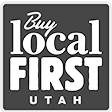Putting Down Roots
Often people believe that the first homes in Utah were built in Salt Lake City upon Brigham Young and his followers supposedly claiming, ‘This is the place!’ He led his Mormons here and founded Salt Lake City in 1947 and over the following decade 90 Mormon settlements arose in the state. Nope, the first recorded home in the state built by a white man was in Odgen, and it’s still standing almost 200 years later.
The Miles Goodyear cabin was built in 1947 by a fur trapper and trader who built his home made up of wood that he hand-sawed from the cottonwood trees along the banks. He is credited with creating Fort Buenaventura there which became a home base for Goodyear, his Ute wife Pomona and their kids, other natives, trappers and travelers heading across the country. The fort had four log cabins, corrals, sheds and a large garden enclosed behind log walls surrounding the site. He sold the fort, his animals and all the buildings there to a Mormon named James Brown for $1,950 and the area became known as Brownsville, then later as Odgen.
Only rich people had homes with hardwood or stone floors back in the day, and for centuries most humans had lived with dirt floors. Thus came the phrase ‘dirt poor’ to identify those without enough money for a nicer abode. During the winter occupants would throw down straw over their dirt floors to soak up mud and snow tracked into their cabins. Straw, unlike hay, is the stalks of grains like wheat after the seeds have been removed and this is called ‘thresh’. Many cabin owners in the day would then put a board across the floor of the main door’s entrance to keep the thresh inside the home, which is where we get the phrase, ‘thresh hold’.
Goodyear himself was orphaned at the age of four and according to history spent most of his youth as an indentured servant. Like so many optimists he headed west to find his fortune and became a successful trapper and trader of fur pelts. When he finally settled down in now Odgen he built the fort to protect his family and livestock. He did marry the daughter of the Ute Chief Pe-teet-neet, so he may have just needed protection from bears and cougars rather than native tribes. His optimism led him to sell the fort and seek gold in the Sierra Nevada’s. He did find the ore but died at the age of 32 in 1849.
You can visit the Fort and camp there along the river anytime between April and November. It’s a Utah State Park with 84 acres with cabin replicas, a visitor center, Goodyear’s cabin, picnic tables, canoe rentals, restrooms and an annual Mountain Man Easter Rendezvous and OFOAM’s Odgen Music festival. There’s also an 18-hole championship disc golf course where competitions are held regularly.








